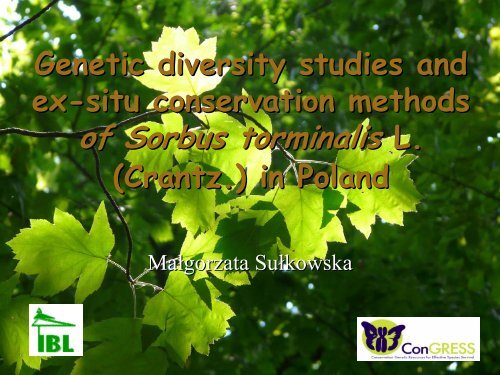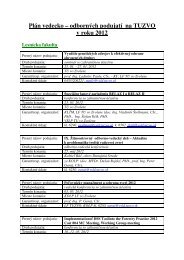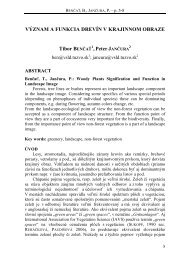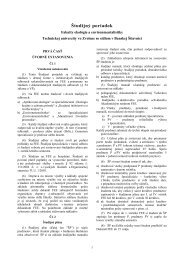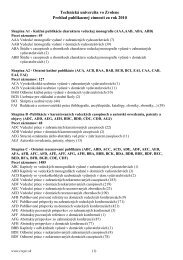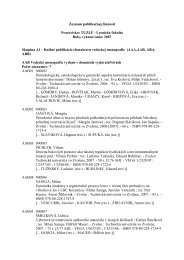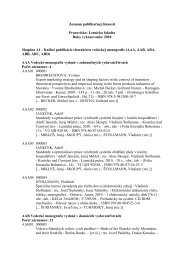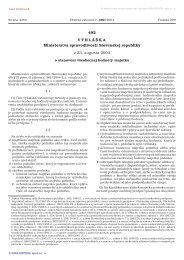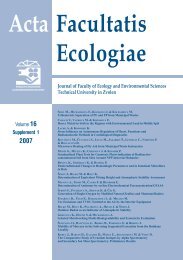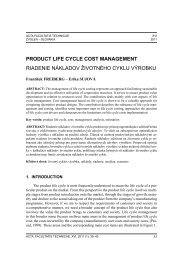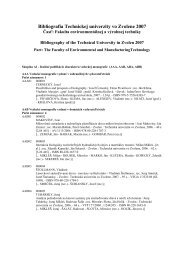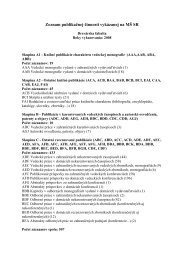Genetic diversity studies and ex-situ conservation methods of ...
Genetic diversity studies and ex-situ conservation methods of ...
Genetic diversity studies and ex-situ conservation methods of ...
You also want an ePaper? Increase the reach of your titles
YUMPU automatically turns print PDFs into web optimized ePapers that Google loves.
<strong>Genetic</strong> <strong>diversity</strong> <strong>studies</strong> <strong>and</strong><br />
<strong>ex</strong>-<strong>situ</strong> <strong>conservation</strong> <strong>methods</strong><br />
<strong>of</strong> Sorbus torminalis L.<br />
(Crantz.) in Pol<strong>and</strong><br />
Małgorzata Sułkowska
Introduction<br />
Sorbus torminalis reaches maximum<br />
height within 100 years. The trees are<br />
typically 20 – 25 m in height with<br />
trunks <strong>of</strong> up to 100 cm diameter. The<br />
species is polinated by general<br />
pollinators like social bees <strong>and</strong> beetles.<br />
The fruits are dispersed by birds <strong>and</strong><br />
by mammals (foxes, martens). The tree<br />
can be easily maintained by planting<br />
or grafting.
Introduction<br />
Wild service tree is strictly protected <strong>and</strong> threatened<br />
species. It is typical for mixed hardwood forests.<br />
It is a light dem<strong>and</strong>ing species.<br />
Wild service tree favors deep fertile soils, but can<br />
tolerate a wide range <strong>of</strong> soil conditions, from chalky,<br />
superficial, dry soils to temporarily waterlogged soils.
Distribution range <strong>of</strong> wild service tree<br />
Browicz K., Gostyńska-Jakuszewska M. 1966. Atlas rozmieszczenia drzew i krzewów w Polsce. Zeszyt 5.<br />
Edit. St. Białobok, Z. Czubiński. Zakład Dendrologii i Arboretum Kórnickie Polskiej Akademii Nauk.
Biology <strong>and</strong> ecology<br />
Sorbus torminalis can hybridize with two other species: white<br />
bean (S. aria) <strong>and</strong> mountain ash (S.aucuparia). Hybridization<br />
with white bean commonly occurs as S.torminalis (father) to S.<br />
aria (mother). It is rarely followed by cytoplasmic introgression.<br />
As a consequence, this geneflow should not significantly affect<br />
the <strong>diversity</strong> dynamics within wild service tree.
Importance <strong>and</strong> use<br />
Wood <strong>of</strong> the wild service tree is very dense <strong>and</strong> has good bending<br />
strength. It was used in the past to make screws for winepresses,<br />
billiard queue sticks <strong>and</strong> musical instruments. Today, it is usually<br />
used for decorative veneers. The species is favoured by hunters,<br />
because its fruits are well appreciated by many birds <strong>and</strong> a few<br />
mammals. The fruits are also used to produce liquors, especially<br />
in Germany <strong>and</strong> Austria. In Pol<strong>and</strong>, this species is almost not used<br />
due to lack <strong>of</strong> supply.
Recommendations for <strong>conservation</strong> <strong>of</strong> genetic resources<br />
jarzębu<br />
brekinii developed in the work EUFORGENU<br />
(Demesure<br />
1996, Rotach 1999) include:<br />
• identification <strong>and</strong> protection <strong>of</strong> natural populations,<br />
• introduction <strong>of</strong> the species in groups <strong>and</strong> creating optimal conditions<br />
for growth by increasing access <strong>of</strong> light <strong>and</strong> reduce competition from<br />
other species,<br />
• initiation <strong>of</strong> natural regeneration <strong>and</strong> establishment <strong>of</strong> crops,<br />
• development <strong>of</strong> procedures for storing <strong>of</strong> seeds <strong>and</strong> their stratification,<br />
ication,<br />
• selection <strong>of</strong> material for wide use - through the selection <strong>and</strong> use <strong>of</strong><br />
individual trees<br />
• increase awareness <strong>of</strong> foresters, regarding the needs <strong>conservation</strong> <strong>of</strong><br />
the species.
The recommendations prepared<br />
Tarnawski (2001) for Polish conditions:<br />
• Creating <strong>of</strong> bio-groups <strong>of</strong> wild service trees or single<br />
individuals,<br />
• increasing access <strong>of</strong> light by the removal <strong>of</strong> trees heavily<br />
shading,<br />
• protection against grazing for natural regeneration,<br />
• enlarging the area <strong>of</strong> the species through planting,<br />
• instructing <strong>of</strong> forest workers <strong>and</strong> forest service<br />
companies for the purpose <strong>and</strong> need <strong>of</strong> the species<br />
protection <strong>and</strong> its characteristics.
Forest Practise<br />
• A lot <strong>of</strong> big work in small scale in different forest<br />
division esspecialy in North Pol<strong>and</strong> (Wejherowo(<br />
Wejherowo,<br />
Goraj, Zielonagora, Osie, Jamy)<br />
• Arboretum in Syców – 80 000 <strong>of</strong> seedlings from<br />
one Piaski population were introduced in Norh<br />
<strong>and</strong> West Pol<strong>and</strong><br />
• In Wejherowo probably 2 000 tseedlings from 2<br />
trees were planted in the forests <strong>of</strong> North Pol<strong>and</strong>
Aim <strong>of</strong> the project BLP-334<br />
is to identify genetic variability <strong>and</strong> population<br />
differentiation <strong>of</strong> wild service tree in Pol<strong>and</strong> using<br />
molecular markers. The results <strong>of</strong> <strong>studies</strong> will the<br />
basis to elaborate program to protect the genetic<br />
resources <strong>of</strong> the species <strong>and</strong> a determination <strong>of</strong> the<br />
possibilities <strong>and</strong> principles <strong>of</strong> its plantations<br />
growing under natural conditions in Pol<strong>and</strong>.
State <strong>of</strong> the art<br />
1. Tuchola, 2. Osie, 3. Opalenie, 4. Jamy, 5. Zielonagóra,<br />
6. Goraj, 7. Gryfino, 8. Bielinek, 9. Bytyń,<br />
10. Wielkopolski PN, 11. Promno, 12. Koło, 13. Potarzyca,<br />
14. Taczanów, 15. Piaski, 16. Legnica, 17. Jawor,<br />
18. Złotoryja, 19. Strzelce, 20. Białowódzka Góra<br />
• BEDNORZ L. (2004): Rozmieszczenie i zasoby Sorbus torminalis (Rosaceae:<br />
Maloideae) w Polsce. Fragm. Flor. Geobot. Polonica 11: 105-121<br />
121<br />
• BEDNORZ L., MYCZKO Ł., KOSIŃSKI SKI P. (2004): Isozyme polymorphism <strong>and</strong><br />
genetic structure <strong>of</strong> the population <strong>of</strong> Sorbus torminalis (L.) Crantz from the Bytyń<br />
Forest (Pol<strong>and</strong>). J. Appl. Genet. 45, 3: 321-324<br />
324<br />
• BEDNORZ L. (2007): Conservation <strong>of</strong> genetic resources <strong>of</strong> Sorbus torminalis in<br />
Pol<strong>and</strong>. Dendrobiology 58: 3-73
State <strong>of</strong> the art<br />
Until now we do not have plantations <strong>of</strong><br />
Sorbus torminalis in Pol<strong>and</strong>. Starting<br />
such <strong>studies</strong> give the possibility <strong>of</strong><br />
cultivation should be precede the<br />
breeding <strong>of</strong> sufficient quantities <strong>of</strong><br />
seedlings that are the <strong>of</strong>fspring <strong>of</strong> the best<br />
trees in terms <strong>of</strong> increment <strong>and</strong><br />
qualitative characteristics. Plantations<br />
can form <strong>of</strong> <strong>ex</strong>-<strong>situ</strong> preservation measure<br />
for wild service tree in Pol<strong>and</strong>.
Sorbus torminalis geographic<br />
localisation <strong>of</strong> populations <strong>and</strong><br />
their genetic distances (Nei 78) on<br />
the base <strong>of</strong> DNA nuclear<br />
microsatelite markers<br />
Localisation<br />
Natural range<br />
0.6163 0.3526 0.3278 0.2126 0<br />
Populacja Kod<br />
kolorów:<br />
1. Tuchola<br />
3. Opalenie<br />
4. Jamy<br />
2. Osie<br />
5. Zielonagóra<br />
13. Potarzyca<br />
14. Taczanów<br />
15. Piaski<br />
17. Jawor<br />
18. Złotoryja<br />
19. Strzelce<br />
20. Białowódzka Góra<br />
6. Goraj<br />
7. Gryfino<br />
9. Bytyń<br />
11. Promno<br />
12. Koło<br />
10. Wielkopolski PN<br />
8. Bielinek<br />
16. Legnica
Geographic localisation <strong>of</strong> populations<br />
<strong>and</strong> their genetic distances (Nei 78) on the<br />
base <strong>of</strong> PCR-RFLP DNA chloroplast<br />
markers<br />
1. Tuchola<br />
2. Osie<br />
4. Jamy<br />
7. Gryfino<br />
8. Bielinek<br />
11. Promno<br />
12. Koło<br />
13. Potarzyca<br />
14. Taczanów<br />
15. Piaski<br />
18. Złotoryja<br />
6. Goraj<br />
16. Legnica<br />
20. Białowódzka Góra<br />
3. Opalenie<br />
19. Strzelce<br />
5. Zielonagóra<br />
9. Bytyń<br />
10. Wielkopolski PN<br />
17. Jawor
<strong>Genetic</strong> knowledge other <strong>studies</strong><br />
‣Investigations <strong>of</strong> the population genetics <strong>of</strong> wild service<br />
tree are based on surveys with neutral genetic markers.<br />
‣The level <strong>of</strong> differentiation between populations was low<br />
compared to other European scattered broadleaves. On a<br />
regional scale, no phylogeo-graphic structure was found.<br />
‣Chloroplast DNA <strong>studies</strong> on a European scale showed a<br />
weak phylogeographic structure,<br />
‣ Intensive seed movement could have blurred a pre<strong>ex</strong>isting<br />
phylogeographic structure.
Threats to genetic <strong>diversity</strong><br />
The main causes contributing to the endangerment <strong>of</strong><br />
the species are:<br />
•narrow genetic seed basis effective population sizes<br />
•the species is particularly threatened by habitat<br />
fragmentation <strong>and</strong> lack <strong>of</strong> natural regeneration,<br />
• competition with other species,<br />
• inadequate silvicultural management – the species<br />
should be released at each logging intervention,<br />
• uncontrolled seed transfer
<strong>Genetic</strong> <strong>conservation</strong> <strong>and</strong> use<br />
Identification <strong>and</strong> protection <strong>of</strong> the<br />
most valuable natural st<strong>and</strong>s in-<strong>situ</strong> is<br />
the most crucial for <strong>conservation</strong> <strong>of</strong><br />
gene resources <strong>of</strong> the species <strong>and</strong><br />
preservation <strong>of</strong> its adaptive possibilities.<br />
For now, it is not possible to indicate a<br />
critical population size below which the<br />
populations would be threatened.<br />
The identification <strong>of</strong> natural „enemies”<br />
like pathogenic fungies is also very<br />
important.
Guidelines for genetic <strong>conservation</strong> <strong>and</strong> use<br />
Conservation efforts need to be<br />
focused on common forestry<br />
management oriented in favour<br />
<strong>of</strong> each single tree:<br />
competition from neighbouring<br />
trees must be controlled,<br />
the seed trees <strong>of</strong> the<br />
neighbouring compartments will<br />
also contribute to regeneration,<br />
it is important to ensure a<br />
regular distribution <strong>of</strong> wild<br />
service tree even with small<br />
clusters or single individuals.
Guidelines for genetic <strong>conservation</strong> <strong>and</strong> use<br />
When it is not possible to apply in <strong>situ</strong> <strong>conservation</strong>, or<br />
measures for seed supply, <strong>ex</strong> <strong>situ</strong> <strong>conservation</strong> must be<br />
considered:<br />
the seeds must be collected from many trees with a<br />
distance <strong>of</strong> more than 200 m between them, to enlarge<br />
the genetic basis <strong>and</strong> to avoid relatedness,<br />
planting conditions must be carefully controlled,<br />
the strategy could be combined with ecological<br />
engineering techniques used in environmental<br />
restoration projects <strong>and</strong> establishment <strong>of</strong> seed banks.
Thank You<br />
very much<br />
for Your<br />
attention!<br />
Białowódzka Góra Reserve (Pieniny Mts.)


